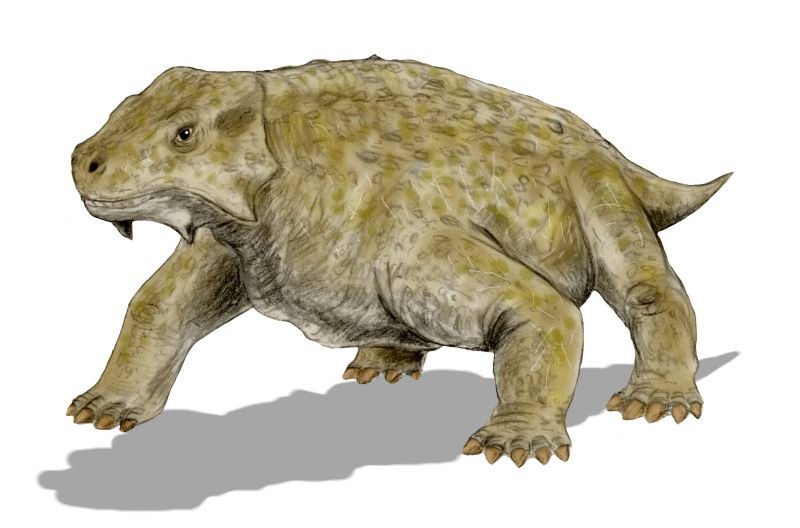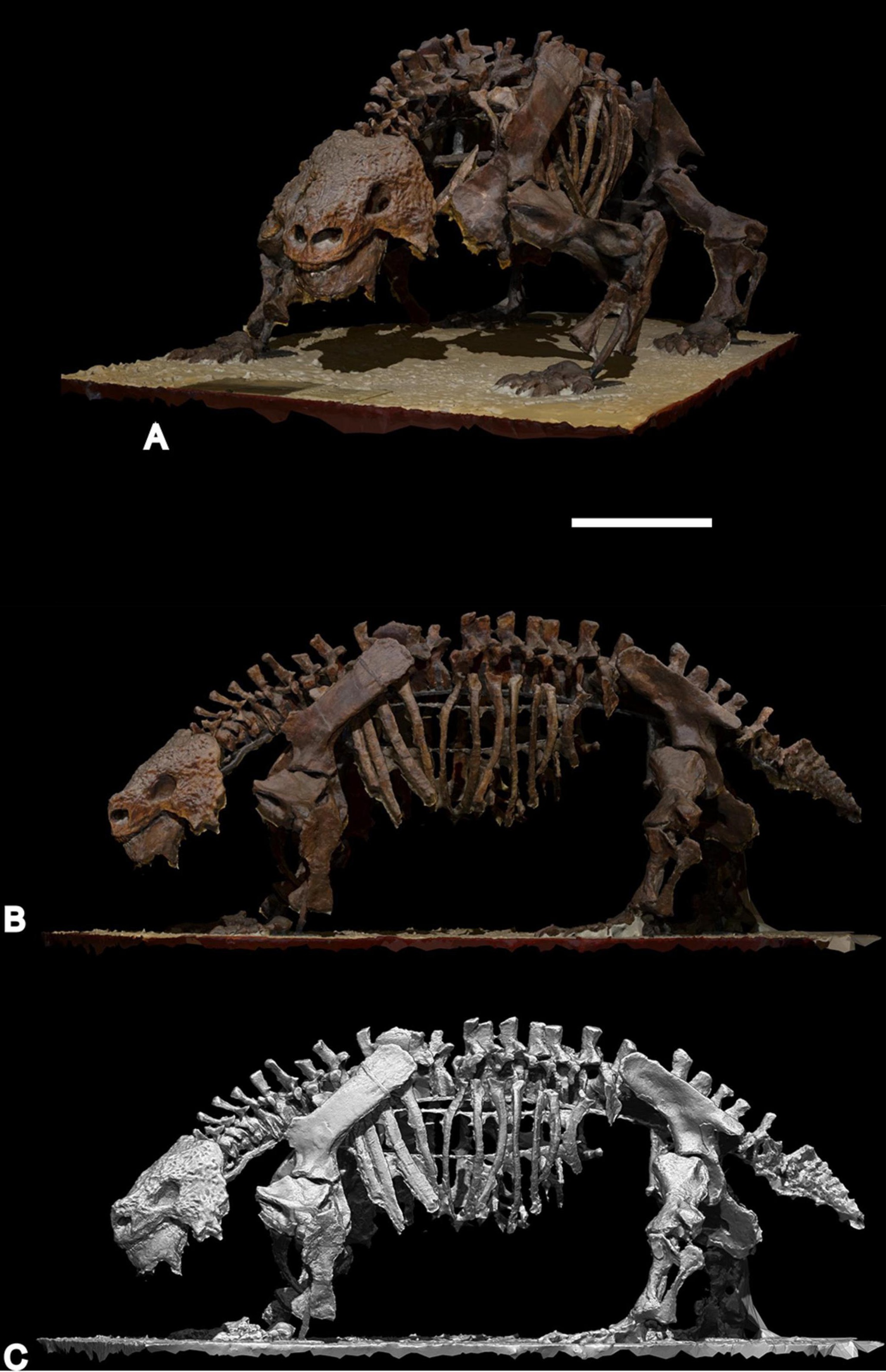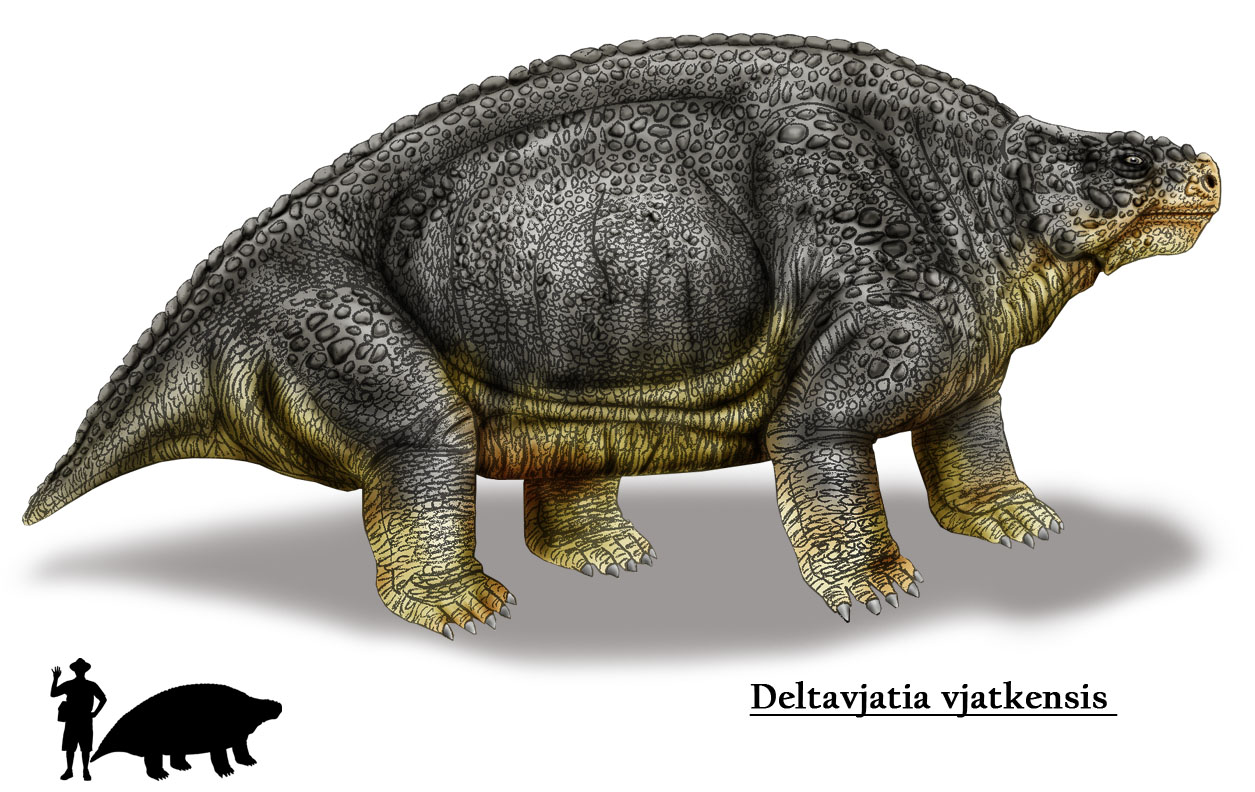|
Pareiasaur
Pareiasaurs (meaning "cheek lizards") are an extinct clade of large, herbivorous parareptiles. Members of the group were armoured with scutes which covered large areas of the body. They first appeared in southern Pangea during the Middle Permian, before becoming globally distributed during the Late Permian. Pareiasaurs were the largest reptiles of the Permian, reaching sizes equivalent to those of contemporary therapsids. Pareiasaurs became extinct at the end of the Permian during the Permian-Triassic extinction event. Description Pareiasaurs ranged in size from long, and may have weighed up to . They were stocky, with short tails, small heads, robust limbs, and broad feet. The cow-sized species '' Bunostegos'', which lived 260 million years ago, is the earliest known example of a tetrapod with a fully erect posture as its legs were positioned directly under its body. Pareiasaurs were protected by bony scutes called osteoderms that were set into the skin. Their heavy skulls ... [...More Info...] [...Related Items...] OR: [Wikipedia] [Google] [Baidu] |
Pareiasaurus
''Pareiasaurus'' is an extinct genus of pareiasauromorph reptile from the Permian period. It was a typical member of its family, the pareiasaurids, which take their name from this genus. Fossils have been found in the Beaufort Group. Description ''Pareiasaurus'' is a large quadruped, about long, with elephantine legs, walking in a typically reptilian posture. The skull is broad and the snout short. Its skull had several spine- and wart-like protrusions. ''Pareiasauruss leaf-shaped teeth, ideal for biting through tough plant fibers, indicate it was a herbivore. Even the palate The palate () is the roof of the mouth in humans and other mammals. It separates the oral cavity from the nasal cavity. A similar structure is found in crocodilians, but in most other tetrapods, the oral and nasal cavities are not truly s ... had teeth. Species ''P. nasicornis'' (Haughton and Boonstra, 1929) is from the ''Tropidostoma'' Zone, Karoo basin, South Africa. This early form is o ... [...More Info...] [...Related Items...] OR: [Wikipedia] [Google] [Baidu] |
Scutosaurus
''Scutosaurus'' ("shield lizard") is an extinct genus of pareiasaur parareptiles. Its genus name refers to large plates of armor scattered across its body. It was a large anapsid reptile that, unlike most reptiles, held its legs underneath its body to support its great weight. Fossils have been found in the Sokolki Assemblage Zone of the Malokinelskaya Formation in European Russia, close to the Ural Mountains, dating to the late Permian (Lopingian) between 264 and 252 million years ago. Research history The first fossils were uncovered by Russian paleontologist Vladimir Prokhorovich Amalitskii while documenting plant and animal species in the Upper Permian sediments in the Northern Dvina River, Arkhangelsk District, Northern European Russia. Amalitskii had discovered the site in 1899, and he and his wife Anne Amalitskii continued to oversee excavation until 1914, recovering numerous nearly complete and articulated (in their natural position) skeletons belonging to a menage ... [...More Info...] [...Related Items...] OR: [Wikipedia] [Google] [Baidu] |
Deltavjatia
''Deltavjatia'' was a pareiasauromorph procolophonoid from the Tatarian stage of the Permian time period. It had a large body of about in length. ''Deltavjatia'' was an herbivore and lived in what is now Russia. The first specimen of ''Deltavjatia'' was a specimen of a skull and lower mandible (PIN 2212/1), found in the Urpalov Formation in Kotelnich, Vyatka River. Since then, numerous mostly complete skeletons have been found, many of them being so well preserved due to the silty, anaerobic environment of the Kotelnich deposits that fossilised white blood cells are able to be distinguished in them. Analyses of the bone histology of ''Deltavjatia'' show that they grew very rapidly during the early stages of their ontogeny but that their growth rate drastically slowed down once they reached approximately half of their full body size. ''Deltavjatia'' was placed as a subtaxon of Pareiasauridae by M.S.Y. Lee in 1997. See also *Pareiasaur *Procolophonia *Kotelnich *Vyatka (river ... [...More Info...] [...Related Items...] OR: [Wikipedia] [Google] [Baidu] |
Provelosaurus
''Provelosaurus'' is an extinct Pareiasaur genus of the Late Permian found on the road between Aceguá and Bagé in the Paleorrota, Rio Grande do Sul, Brazil. Found in the Rio do Rasto Formation, aged about 260 million years.http://www.ufrgs.br/geociencias/paleo/pareiassauro2.html Museu da UFRGS The holotype specimen found measures in length.Juan C. Cisneros, Paula Dentzien-Dias and Heitor Francischini. 2021. "The Brazilian Pareiasaur Revisited". ''Frontiers in Ecology and Evolution'' Classification Originally described as a South American representative of the genus ''Pareiasaurus ''Pareiasaurus'' is an extinct genus of pareiasauromorph reptile from the Permian period. It was a typical member of its family, the pareiasaurids, which take their name from this genus. Fossils have been found in the Beaufort Group. Descri ...'', it was assigned to a new genus ''Provelosaurus'' by Lee (1997), who noted it shows more affinities with the small, highly derived, South Afri ... [...More Info...] [...Related Items...] OR: [Wikipedia] [Google] [Baidu] |
Bunostegos
''Bunostegos'' ("knobbly kullroof") is an extinct genus of pareiasaur parareptile from the Late Permian of the Agadez Region in Niger. The type species, ''Bunostegos akokanensis'', was named from the Moradi Formation in 2003. It was a cow-sized animal with a distinctive skull that had large bony knobs, similar in form to those of other pareiasaurs but far larger. The species appears to have lived in a desert in the centre of the supercontinent of Pangaea. Analysis of the limb bones (including the scapulocoracoid, humerus, radius, ulna, pelvis, and femur) was published in 2015, and revealed that ''Bunostegos'' walked upright on four limbs, with the body held above ground. This new information directly suggests that it could be the first tetrapod with a fully erect gait. Description The animal has been described as about the size of a modern cow with a knobbly skull and bony plate armor on its back." Its teeth show it to have been a plant eater. It lived in an isolat ... [...More Info...] [...Related Items...] OR: [Wikipedia] [Google] [Baidu] |
Velosauria
Velosauria is a group of pareiasaur reptiles that existed in the late Permian period. They ranged in size from the 50-centimeter-long ''Pumiliopareia'' to the 3-meter-long ''Scutosaurus''. Velosaurs were some of the largest reptiles of their time. Description Velosaurs were large reptiles that were characterized by their short tails, small heads, broad feet, and their legs, which were directly in between sprawling and semi-erect. Velosaurs' bodies were covered in osteoderms and smaller scales all over. Their heads came in all sorts of different shapes; from the cheek-frilled ''Scutosaurus ''Scutosaurus'' ("shield lizard") is an extinct genus of pareiasaur parareptiles. Its genus name refers to large plates of armor scattered across its body. It was a large anapsid reptile that, unlike most reptiles, held its legs underneath its b ...'' to the spiky-headed '' Elginia'' to the nose-horned '' Arganaceras''. They were herbivorous, and it is believed that their large bodies house ... [...More Info...] [...Related Items...] OR: [Wikipedia] [Google] [Baidu] |
Parasaurus
''Parasaurus'' (meaning "near lizard") is a genus of pareiasaur known from fossils collected in the Kupferschiefer in Germany (Hesse, Thuringia and Lower Saxony), dating to the Late Permian ( Wuchiapingian). The type species, ''Parasaurus geinitzi'', described by Hermann von Meyer in 1857, was the first pareiasaur ever described. The seven known specimens were redescribed in 2008.L. A. Tsuji and J. Müller. (2008). A Re-evaluation of ''Parasaurus geinitzi'', the first named pareiasaur (Amniota, Parareptilia). Canadian Journal of Earth Sciences 45(10):1111-1121 Discovery and naming As early as 1848, pareiasaur fossils have been reported from Germany; some of these fossils may have belonged to ''Parasaurus''. It was not until 1857 when von Meyer described these fossils and created the ''Parasaurus'' genus.Meyer, H.V. (1857). Beiträge zur näheren Kenntnis fossiler Reptilien. ''Neues Jahrbuch für Mineralogie, Geognosie, Geologie und Petrefaktenkunde'', 1857: 103–104. von Meyer ... [...More Info...] [...Related Items...] OR: [Wikipedia] [Google] [Baidu] |
Elginia
''Elginia'' is an extinct genus of pareiasaurid known from the Late Permian of Scotland and China. It was named for the area around Elgin in Scotland, which has yielded many fossils referred to as the Elgin Reptiles. Discovery The type species of ''Elginia, Elginia mirabilis,'' was first described in 1893 by E.T. Newton, after fellow geologists John Horne and Archibald Geikie informed him of several unusual specimens stored at the Elgin Museum in Scotland. The specimens were collected several years earlier from the coarse sandstones of the nearby Cutties Hillock Quarry. The quarry’s sandstone, the Cutties Hillock Sandstone Formation, is often (but not always) considered equivalent to the otherwise fossil-poor Hopeman Sandstone Formation of broader Scottish geology. Tetrapod remains occupy a narrow section of the sandstone, lying above a pebbly layer. The sandstones of Cutties Hillock were deposited at the very end of the Permian Period, based on a dicynodont fauna ... [...More Info...] [...Related Items...] OR: [Wikipedia] [Google] [Baidu] |
Anthodon (reptile)
''Anthodon'' (meaning "flower tooth") is an extinct genus of pareiasaurid parareptile from the Permian period of South Africa and Tanzania. History Richard Owen, who described ''Anthodon'', thought it was a dinosaur because dinosaurian skull material from the Early Cretaceous had become associated with the Permian material. The dinosaur material was later separated out by Robert Broom Robert Broom FRS FRSE (30 November 1866 6 April 1951) was a British- South African doctor and palaeontologist. He qualified as a medical practitioner in 1895 and received his DSc in 1905 from the University of Glasgow. From 1903 to 1910, ... in 1912 and was renamed as the stegosaurid '' Paranthodon'' by Franz Nopcsa in 1929. Description This small form combines the primitive feature of interpterygoid fenestrae with an advanced feature of turtle-like armor. It was about in length, and weighed around . Small dermal ossicles covered the body, while the pattern of armor plates on the ba ... [...More Info...] [...Related Items...] OR: [Wikipedia] [Google] [Baidu] |
Bradysaurus
''Bradysaurus'' was a large, early and common pareiasaur, the fossils of which are known from the '' Tapinocephalus'' Assemblage Zone (Capitanian age) of the South African Karoo. Along with the similarly large dinocephalia, the bradysaurs constituted the herbivorous megafauna of the late Middle Permian Period. In life they were probably slow, clumsy and inoffensive animals, that had evolved a covering of armoured scutes to protect them against their predators, the gorgonopsians. Description ''Bradysaurus'' was in length and half a tonne to a tonne in weight. The skull was large (about 42 to 48 centimeters long), broad and rounded at the front. It was coarsely sculptured and knobby, with the sutures between the bones not clearly visible. The marginal teeth were high-crowned, with only a few cusps, which is a primitive characteristic. The feet were short and broad, the phalangeal count being 2,3,3,3,2 on the fore-foot and 2,3,3,4,3 on the hind. The whole body is prot ... [...More Info...] [...Related Items...] OR: [Wikipedia] [Google] [Baidu] |
Embrithosaurus
''Embrithosaurus'' was a pareiasaur from the Permian of South Africa. Description ''Embrithosaurus'' was in length and in weight. The skull is relatively deep and narrow. The body is lightly armoured with thin, smooth dermal scutes. Species * ''E. schwarzi'' (Watson, 1914). The type species. This is the most advanced species of this genus, as indicated by the teeth, which have nine cusps (in three groups of three). In cladistic analyses it is used as the monotypal species for the genus. * ''E. alexanderi'' (Haughton and Boonstra, 1929). This species was made the type for ''"Dolichopareia"''. As the name indicates, the skull is long and narrow. This would seem to indicate a different lifestyle or diet to other parieasaurs. More recently, it has been used as the monotypal species for the genus ''Nochelesaurus'' (it is not clear what the status of ''Embrithosaurus strubeni'' is, this may be a further transitional species). In cladistic analyses, this species is phylogenetically in ... [...More Info...] [...Related Items...] OR: [Wikipedia] [Google] [Baidu] |





